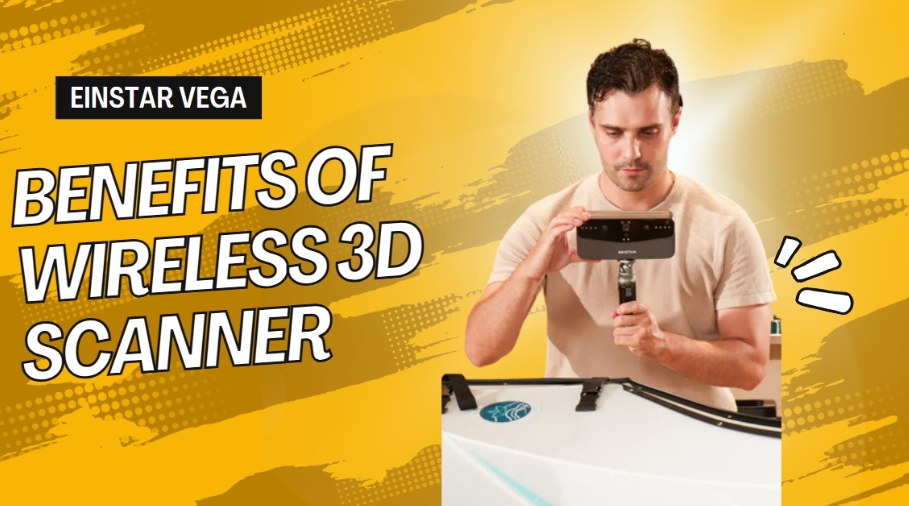Creativity requires instant response and record. In the 3D industry, this is especially true. Portable 3D scanner, as one of the most important tools in 3D projects, bridges your brain world to the real world.
In video game design, 3D scanning offers greater convenience—developers can scan real-world objects, refine them in post-processing software, and seamlessly integrate the optimized digital models into virtual environments, eliminating the need to build them from scratch. It can also be seen in applications in DIY projects, healthcare, education, and cultural preservation.
Keep scrolling to learn more details on the portable 3D scanner, and the further edition – wireless portable 3D scanner.
What Is a Handheld 3D Scanner?
As 3D scanning technology becomes more accessible, technology enthusiasts are integrating it into their creative and practical projects. A handheld 3D scanner is a portable device used to capture the dimensions, geometry, and surface details of physical objects in 3D. It works by “painting” the object with structured light or laser light as the operator moves the device around it. This way, it continuously captures data to produce a digital 3D model.
Stationary 3D Scanners
Stationary 3D scanners are fixed systems designed for controlled, high-detail scanning in a stable environment. They typically consist of a structured setup, such as a mounted scanner with a turntable or multiple cameras/lasers arranged in a fixed position.
The object being scanned must be placed within the scanner’s defined capture volume, and the system relies on precise alignment to generate a complete 3D model. These scanners are commonly used in laboratories, manufacturing, and quality control settings where repeatability and environmental control are critical.
Portable (Handheld) 3D Scanners
Portable 3D scanners are mobile, lightweight devices that allow users to move freely around an object while capturing 3D data. Unlike stationary scanners, they can be used in various environments, including on-site locations.
Many handheld scanners use optical tracking, infrared sensors, or laser projection to maintain scan consistency while in motion. These scanners are ideal for scanning large objects or structures that cannot be moved, offering flexibility and adaptability in real-world conditions.
Handheld vs. Stationary 3D Scanners: What’s the Difference?
Both handheld and stationary (wired) 3D scanners have their unique advantages, disadvantages, and use cases.
| Stationary (Fixed) 3D Scanners | Handheld 3D Scanners | |
| Setup & Mobility | Mounted on a stand/tripod; requires turntable or fixed object. | Portable; can move freely around the object. |
| Best For Object Size | Small to medium objects (e.g., jewelry, precision parts). | Large objects or hard-to-reach areas (e.g., cars, furniture, sculptures). |
| Accuracy & Resolution | Generally provide higher resolution and accuracy than handheld scanners. | Often offers greater portability but with slightly lower precision due to motion-dependent scanning. |
| Scanning Speed | Slower (requires multiple scans + alignment) but consistent. | Faster real-time scanning, but may need more post-processing. |
| Workflow | Stationary 3D scanners require a fixed setup location and rely on either an automated turntable or manual object rotation by the user to capture all necessary angles for scanning. | Flexible for on-site, fieldwork, or dynamic scanning. |
| Ease of Use | Great for handling repetitive, standardized workflows, especially with automated turntables. | More user-friendly with live feedback; easier for quick scans. |
What is a Wireless 3D Scanner? What is the Advantage?
Compared to stationary 3D scanners, handheld scanners offer greater flexibility. The lighter and integrated design allows users to scan objects in a more complex environment. However, most handheld 3D scanners should connect with peripherals, for a power supply, data transmission, or others. That is a head shake, especially in on-site scanning.
Considering the growing demand for net-free scanning, wireless scanning emerges. They eliminate these constraints with:
True cable-free operation (no power cords/PC dependencies)
Unmatched adaptability for challenging environments (tight spaces, uneven terrain)
EINSTAR VEGA Wireless Handheld 3D Scanner
For hobbyists, designers, educators, and digital artists who want an easy-to-use yet powerful 3D scanner, the EINSTAR VEGA is a fantastic choice. The compact, all-in-one wireless 3D scanner makes 3D scanning simple, fast, and accessible—perfect for creative projects, prototyping, and digital archiving. It features:
All-in-One, No Computer Needed
Built-in processing – Scan, preview, and save 3D models directly on the device—no PC or phone required.
Dual scanning modes – Switch between Fast Scan (20 FPS) for quick captures and HD Scan (15 FPS) for finer details.
Works Anywhere, Anytime
Scans in any lighting – Handles indoor, outdoor, bright sunlight, or low-light conditions thanks to advanced infrared projection.
Great for various objects: features Fast Mode for scanning medium to large items like furniture, sculptures, props, and HD Mode for smaller objects with details (toys, figurines, craft pieces).
Cloud & Sharing Made Easy
Allow one-click cloud upload – Save and share scans via Einstar’s digital cloud for easy collaboration.
Lightweight & Comfortable
Only 535g (1.18 lbs) – Easy to hold for long scanning sessions.
Ergonomic grip – Designed for smooth, steady movements.
Great for Creative & Educational Use
- Good detail capture – Ideal for game mods, 3D printing, VR/AR content, and school projects.
- User-friendly software – Clean up and refine scans with intuitive tools.

Wrapping Up
Handheld 3D scanners are making digital modeling more accessible. Explore the technology with EINSTAR to spark your creativity.






























